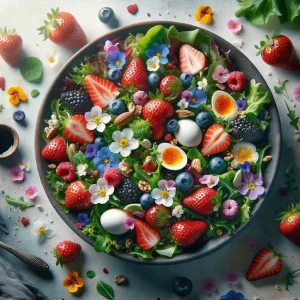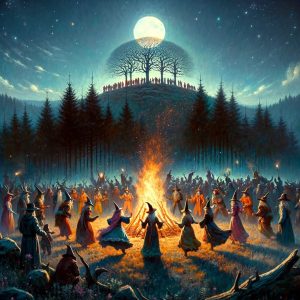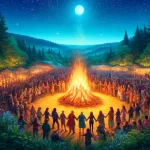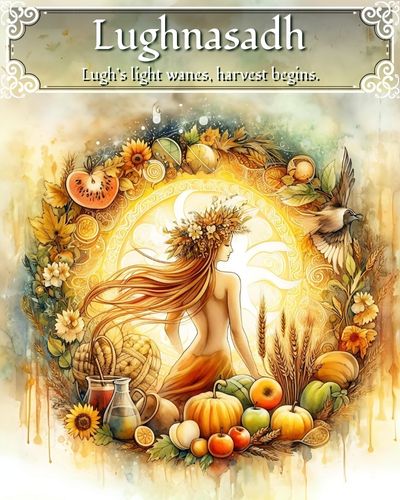
Approx. Reading time: About 6 Minutes

Introduction
Mea’n Fo’mhair
Mea’n Fo’mhair The Celtic Celebration of Autumn Equinox As the wheel of the year turns once more, we arrive at a moment of perfect balance between light and dark. The day and night are equal in length, marking the transition from summer to autumn. This is Mea’n Fo’mhair, pronounced “mayn fo-vahr,” a traditional Celtic festival that celebrates the Autumn Equinox. Also known as the “Middle of Harvest” or “Mabon” in modern Pagan and Wiccan traditions, Mea’n Fo’mhair has deep roots in Celtic history and culture.
Mea’n Fo’mhair is a time to honor the bounty of nature, to express gratitude for the fruits of our labor, and to share our abundance with others. It is also a time to reflect on our lives, to seek balance within ourselves and in our relationships, and to honor the wisdom of our ancestors. In this article, we will explore what Mea’n Fo’mhair is, its historical origins, its celebration in the past, and how it continues to be observed in the present. We will also discover how Mea’n Fo’mhair can help us find harmony and equilibrium in our lives, as we align ourselves with the natural rhythms of the Earth.

What is Mea’n Fo’mhair?
Mea’n Fo’mhair is a Gaelic term that translates to “middle of autumn.” It signifies the moment of balance when day and night are of equal length, marking the official start of autumn in the Celtic calendar. This festival is an occasion to give thanks for the year’s bountiful harvest, express gratitude for nature’s abundance, and prepare for the approaching winter months.
In the enchanting dance of celestial bodies, Mea’n Fo’mhair marks a precise moment when the Earth finds itself in perfect equilibrium. It is that exquisite juncture when the sun graces the world with precisely as much light as darkness, a moment that holds profound symbolism. As daylight and nightfall share the stage, it is a reminder of the delicate equilibrium that governs our existence, where opposites find unity and harmony.
In the ancient Celtic calendar, Mea’n Fo’mhair is the official inception of autumn, a season of transformation and transition. It stands as a testament to the deeply rooted connection between the Celtic people and the rhythms of nature. A moment of transition and reflection, this festival invites us to step into the embrace of autumn’s embrace and let go of the warmth of summer’s embrace.
At its core, Mea’n Fo’mhair is a festival of gratitude. It beckons us to give thanks for the year’s bountiful harvest, a time when the land generously yields its fruits, and the toils of the year’s labor bear fruit. The grains of wheat and barley bow in the fields, offering themselves to the reapers’ hands. Apples hang low on the branches, the embodiment of nature’s sweet gifts. Root vegetables, plucked from the dark earth, symbolize sustenance and abundance. It is a time when communities come together, recognizing the interdependence between humanity and the land that sustains us.
But Mea’n Fo’mhair is not merely about celebrating the abundance of the present; it is also a moment of thoughtful preparation for the future. As the sun’s warmth wanes and the days grow shorter, winter’s specter looms on the horizon. The festival encourages us to store away the riches of summer and the harvest, to prepare for the colder months when the earth rests beneath a blanket of snow.
Mea’n Fo’mhair is a celebration of balance, of gratitude, and of the ever-turning wheel of the seasons. As we stand at the cusp of autumn’s embrace, this Gaelic festival invites us to pause and savor the moment, to express our thanks for nature’s bounty, and to prepare our hearts and homes for the wintry slumber that awaits.
Historical Origins of Mea’n Fo’mhair
The origins of Mea’n Fo’mhair take us on a captivating journey back in time, deep into the annals of Celtic history and culture. In the heartlands of Ireland, Scotland, Wales, and across the expanse of the British Isles, the ancient Celtic peoples thrived, their lives intricately woven into the fabric of the natural world. These communities held a profound reverence for the changing seasons, forging a spiritual bond with the Earth that resonates through the ages.
Mea’n Fo’mhair, a festival that now dances at the edge of autumn, was born from this connection to nature. It served as a sacred bridge between the Celtic tribes and the land they called home, a time when the veil between humanity and the Earth was at its thinnest.
At the heart of this venerable festival lay the cycles of agriculture. The Celtic people were not just observers of the land; they were its stewards, working in harmony with its rhythms. Mea’n Fo’mhair, which translates to “middle of autumn,” was the pivotal moment when these communities would gather to reap the rewards of their toil.
The fields, once awash in the vibrant hues of summer, took on a golden hue as grains like wheat and barley bowed low to the reapers’ scythes. The orchards, heavy with the weight of apples and pears, were ready for the harvest. Root vegetables, diligently nurtured throughout the year, were plucked from the earth’s embrace. This was a time when the land yielded its treasures, a moment of abundance and plenty.
Yet, Mea’n Fo’mhair was not solely a celebration of the land’s generosity. It held a dual significance that spoke to the very essence of the Celtic way of life. As the festival marked the culmination of the agricultural year, it was also a harbinger of the months ahead. The Celtic people knew well the challenges of the approaching winter, when the earth would rest beneath a blanket of snow, and the bounty of summer would be a distant memory.
Thus, Mea’n Fo’mhair was a time of dual purpose. It was a joyous celebration of the earth’s abundance, a moment to revel in the fruits of the year’s labor, to share in the communal feast, and to express gratitude for the land’s generosity. Simultaneously, it was a period of thoughtful preparation, as the community came together to ensure that the stored harvest would sustain them through the darker, colder months. Crops were carefully stored, preserving their vitality for the leaner times ahead.
Mea’n Fo’mhair reflected the Celtic way of life—a harmonious dance with nature’s rhythms, a celebration of the land’s generosity, and a pragmatic preparation for the future. The festival’s ancient roots continue to echo in the contemporary celebrations of the Autumn Equinox, as it invites us all to pause and honor the enduring relationship between humanity and the natural world.
Traditional Celebrations of Mea’n Fo’mhair
In ancient Celtic society, Mea’n Fo’mhair was a time of communal celebration and rituals. Some of the traditional practices and customs associated with the festival included:
- Harvest Feasts: Communities would come together to share the fruits of their labor. A grand feast featuring freshly harvested foods was the centerpiece of the celebration. Roasted grains, root vegetables, and seasonal fruits were prominently featured on the menu.
- Bonfires: Large bonfires were lit to symbolize the waning power of the sun and to provide light and warmth as the days grew shorter and colder. These fires were often lit on hilltops and served as beacons of celebration.
- Offerings to Deities: The Celts believed in various nature and harvest deities. Offerings of grains, fruits, and other agricultural products were made to these deities as a sign of gratitude for a successful harvest season.
- Mumming and Masked Celebrations: People would don masks and costumes, a tradition that may have laid the groundwork for modern Halloween festivities. These masked celebrations were believed to ward off malevolent spirits and ensure a bountiful harvest.
Mea’n Fo’mhair in the Present
Today, Mea’n Fo’mhair is still celebrated, albeit in different forms. Modern Pagans, Wiccans, and individuals interested in nature-based spirituality often observe Mea’n Fo’mhair as part of their rituals and festivals. Some common modern practices and celebrations include:
- Altar Decorations: Many create altars adorned with symbols of the season, such as colorful leaves, gourds, and apples. These altars serve as focal points for reflection, meditation, and offerings.
- Harvest Feasts: Contemporary celebrations often involve preparing and sharing seasonal meals with friends and family. It is a time to connect with loved ones and give thanks for the abundance of the year.
- Rituals and Ceremonies: Rituals may vary but often include elements of gratitude, balance, and reflection. Lighting candles, meditation, and nature walks are common components of these modern rituals.
- Charitable Acts: Some choose to engage in acts of charity, such as donating food to those in need or participating in environmental cleanup efforts, to give back to the community and honor the spirit of Mea’n Fo’mhair.
Conclusion
Mea’n Fo’mhair is a traditional Celtic celebration of the Autumn Equinox with deep historical roots. While the ways in which it is celebrated have evolved over time, the core themes of gratitude for the harvest and preparation for the coming winter remain central to its observance. Whether through ancient customs or modern practices, Mea’n Fo’mhair continues to be a meaningful time to connect with nature and the changing seasons.














